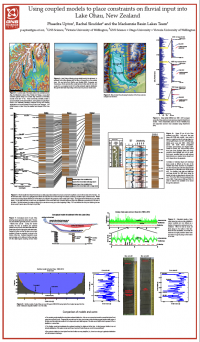CSDMS 2013 annual meeting poster Phaedra Upton
Coupled models place constraints on fluvial input into Lake Ohau, New Zealand
Rachel Skudder, Victoria University of Wellington Wellington , New Zealand. skudderach@myvuw.ac.nz
Abstract:
Lake records provide a long-term record of climate events and transitions, earthquakes in tectonically active regions, landscape response during and following deglaciation and recent human influenced land use changes. In order to unravel the story preserved in lake sediments, it is necessary to understand the dynamics of the lake system and the source of the sediment coming into the lake. Our study focuses on Lake Ohau, New Zealand, which occupies a fault controlled glacial valley and contains a high resolution sedimentary record of the last ~17 ka. It is presently the focus of a multi-disciplinary studied which aims to recover a long core encompassing the whole ~17 ka record in the next several years.
We use two CSDMS codes: HydroTrend, a climate-driven hydrological model, and Sedflux, a basin filling model, to model sediment flux into Lake Ohau. Using measured climate parameters from the last 60 years, we model water and sediment discharge into the lake and the distribution of sediment through the lake basin. Using a simple conceptual model of the lake dynamics, we produce a series of simulations to examine sediment accumulation at different positions across the lake basin. We then compare these modelled accumulation records to short cores from a number of locations within the lake basin.
* Please acknowledge the original contributors when you are using this material. If there are any copyright issues, please let us know and we will respond as soon as possible.

